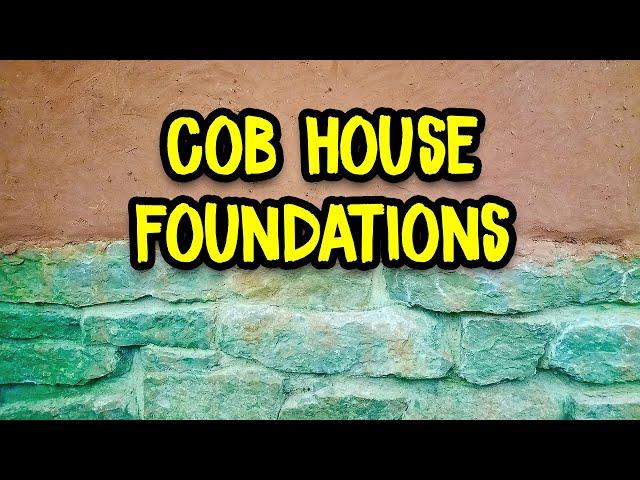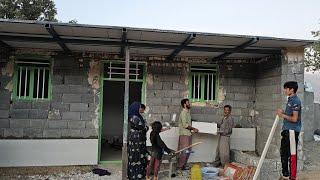
Understanding Foundation Construction - Cob House Foundations Are Important!
Комментарии:

Would you recommend concrete if I wanted to make a pallet cob chicken cob house??
Ответить
Not because of the concrete, your advice is terrible and wrong and accelerates the collapse. NEVER uses concrete directly on earth, like that the cement will suck water like when I'm in a pub Friday 6pm...
Ответить
What would a proper stone foundation look like? How would you do a hybrid of stone/cement?
Ответить
Hey sweetheart it's c o b b
cobb house

Gabion foundations is the answer! No concrete needed or high skill level like dry stacking.
Ответить
What do you make of straw bale construction? It seems risky to me here in the UK with the damp. You see these middle class types move out from the city to the wilds and build them quite unawares of the fact rats can get into anything and if hay gets wet it can spontaneously combust. I suppose I just answered my own question.
Ответить
When I see concrete, it always seems to have cracked from thermal expansion/shrinkage, to the point that pavers put those deliberate divisions into the sidewalk to break up the monolithic nature of the material and allow it to expand and shrink without cracking.
So, if you'll pardon the noob question, why is a monolithic concrete foundation better for building than stone if it breaks under temperature changes? (hell, the same could be asked of cob, though i figured it'd be more "flexible" what with being heterogeneous and permeable?)

Blenheim palace, Versailles palace or any roman arquitecture has never being built with cement or or tires, yet it still stand still after many hundred of years.... Just saying 🤔
Ответить
Dry stone has been around much longer than the concrete we use today so it has stood the test of time. Current concrete works but it definitely has a shorter life expectancy. I think you can see that current concrete if you're lucky will last 75 maybe a little longer. The stability of dry stack probably depends more on the stone mason. A dying skill for sure. I also don't think that calling people stupid because they disagree with your points of view was necessary. I think when people see a house or building that has lasted on dry stack stone for 500 years and they see concrete that hasn't proven it can last 100 years in houses it appears to them your the one that's not to smart. I'm not saying one way or the other is better I'm just stating facts of perception and how inappropriate I thought it was for you to be calling people stupid.
Ответить
Thoughts on rubble trench foundations? We live in Northern MO and planning a cob/bale build.
Ответить
Thanks for the great video
Is drainage beneath or bedside footings better?
Do internal walls need footings? Drainage?
Thanks
Peter

You dont have skills to make a good stone wall. This takes a few years to learn. Sad that you reckomend concrete but I understand why... Learn how they made brick buildings in Scandinavia. The stonewalls there has lasted 200 years. And it is often buildings with 4 floors, and constructed on soil. The trick is thicker support walls. And below freeze point. How you put the rocks defines the quality.
Ответить
You lost me when you calked people stupid and ignorant for not wanting to use concrete.
Ответить
I live in south carolina. Would the moisture out here effect any possibility of me having a Cobb house in these parts? I ask because it rains alot out here. Just wanted to know. ..and if it is possible to own one, what foundation would you recommend for South Carolina? Love your videos and thanx!!🤍
Ответить
Glad to see some common sense about concrete. Seems like I hear how bad it is, and don't use it. To me it is the best material for foundations.
Ответить
How do you join the interior flooring concrete (and other materials shown) with the side of the stem wall? Is it enough to pour the concrete or cob on top of the floor insulation or should we bond those materials some how to the foundation at the cross section?
Ответить
Love the hobbit door ❤
Ответить
Can you please further explain why not to use tires?
Ответить
I'm a carpenter who has built several homes over the past fifteen years. I now spend my winters in Brazil, developing sustainable plans involving timberframing, cobb, and other local building products. I am so happy to see that conventional building practices and structural integrity are being championed in the bioconstruction/ sustainable building arenas. Foundations are incredibly important, and I've seen a few structures (two story cobb and timberframe) built on DRY STACKED STONE! I am not even kidding. One problem with groundwater, or heaving clay, and the whole building would be in jeopardy. Thanks again for stressing the importance of solid monolithic foundations. There's a reason building codes require these, and the weight of cobb (I build with extra thick walls in order to store the sun's heat like a battery) in addition to the huge timbers (25cm+) requires at a minimum thick pedestals for small houses (15m sq. cabins) or conventional footings for anything bigger.
Ответить
I have a degree in structural engineering (not licensed). I'm 100% on board with concrete footings and foundations for cob walls.
But so long as the wall foundations are tied together, strictly speaking you could really do away with the concrete slab floors, at least from a structural point of view. Have you looked into options for rammed earth flooring? I'd be curious what you think about that. I don't have experience in this realm. It seems like a way to save a considerable amount of cement.
I just found your channel yesterday and I'm really enjoying it. Thanks for all your hard work.

Hello, Im building in Gambia an been watching your videos to help, and thank you so much these videos are amazing!
Could you use cube wire cages with stone for the foundation and pour concrete to create that one slab effect? save on concrete (although dont want to skips corners) a what are your thoughts on this?

Surprised you didn’t cover moisture and concrete. My concern is how much water may wick up through the concrete to cause moisture damage to the interior of straw bale walls, especially in cold damp climates. Not to mention the cracking of foundation walls due to the freeze thaw action in such climates.
Ответить
Lot of negativity in this video . Nothing wrong with using any building material , it's what you prefer ! If people don't like it , they aren't stupid or ignorant . Just like you aren't for not liking other foundations either .
Ответить
Nuggets of gold being shared here
Ответить
M for lime/sand concrete + lime-sand-soil blocks combi.
Ответить
I got a lot to learn about Adobe and cob.
I believe I like both..I want to build a 20X30 Cob one room cabin with a small wood burning stove..

What about aircrete? Could that be used for a foundation? I would like to build some cob structures on my property possible a home as well. I would really love to have an earth integrated home or completely underground. Is it possible to use cob for those structures? Also what about rain? What do I have to do in design to accommodate for rains? Or for underground if it's possible? Thank you for your time and assistance and all the videos. Truly appreciated!
Ответить
You say people are stupid!!!! You call people ignorant that are asking you questions.
While watching “part” of your video the voices are talking OVER the people talking. Are these the stupid ignorant people your talking about.
You were so judgmental about other peoples ideas I had to stop watching.
If this is a learning class or study please concentrate on the subject.
Maybe after a year you would have more then 40,000 views

You use concrete, box store lumber, OSB plywood, roof felt, everything else that you would find in todays construction, including the chemicals, oh, but you do use a little bit of cob... Is that really what is intended when trying to use natural materials? I think not... The whole movement is to build affordable, natural housing that's a very affordable alternative to what you build.... And a rigid foundation is much weaker than a moving foundation isn't it? I think it's been proven time and time again. You can build a great foundation without using concrete, period! You don't build "Cob Homes", you build homes with SOME Cob on them.
Ответить
The windows are not up to code, Florida hurricane!
Ответить
Experience and history have demonstrated that the concrete footer upon which the stem wall rests (in the illustration), could be replaced by crushed and compacted stone or rubble.
This way, the "frost line" becomes immaterial because it has insignificant effect on the stone rubble foundation.
Also, experience and history have also shown that imbedding steel rebar into concrete will decrease the longevity of the concrete, as the steel will eventually oxidize causing spalling, fracturing or both. Yet, despite this real-world evidence, most AHJs will be looking for steel rebar to be installed. Why?
From information gleaned over the decades, it appears that most soils in North America, will support the majority of what passes for home construction.
Get your soil tested if in doubt and yes pay attention to the materials and installation of the foundation components.
This is not the area to "cut corners" but it is also foolish to "over engineer" the structure based on modern building "traditions".

I think we would all agree that concrete can be a wonderful material in construction. Like any material, it can be misapplied or be of substandard quality.
Alternative building methods which attempt to mimic or reproduce ancient methods are often void of concrete as a material.
Can a viable foundation be constructed without concrete? Absolutely. Look at the ancient buildings still standing on nothing but stone.
In the interest of keeping costs manageable many seek a building alternative more conducive to DIY.
To call people "stupid" or "ignorant" because they hold a different opinion is somewhat caustic, condescending and adds nothing to the conversation.
Simply, state your case and give the data (empirical or anecdotal) to show how you arrived at your conclusions. Others will consider it, or not.
Just because a truck deposited tons of concrete at your building site, does not guarantee the foundation, slab or anything else will be issue free.
Consider, how many times you have seen concrete being placed and then finished, only to see the crew walk away without addressing the curing process? Answer, almost always.
Why? Because despite the common knowledge that "concrete cures best that cures slow", the contractors (or installers) make no time to address this fundamental and important key element.

Love you're info, solidas a 🪨 foundation or concrete, 😆 🤣 😂
Ответить
Great video, but i have a small Important question.
Is Frost can lift up the gravel or stone when they put it on the frost line ?
Or we need to mix and pour lime or cement with sand after we put the big rocks down there.
But how about the gravel people use in Rubble trench, Frost could lift the gravel up, right ?
So, the only good possible foundation is concrete below the frost line, and the gravel below the concrete to get good water drainage ?

I don't get the drain pipes? From where to they drain to where? If you just surround the ditch with a drain, how does water even get inside it?
Ответить
This dude is way too aggressive the way he talks about people refusing concrete. If they do is mostly because we were pushed to consume a material that should be used only for very specific parts of constructions and yet we use them in walls and really hot or too moist places of the Earth.
Chill , man... If you are sure about your beliefs, just let it be. No need to discharge your frustrations during the video. I gave up watching as green house and cob house should be about a different mindset which you clearly don't have...

I hear ya! I don’t like concrete, but you can’t beat what it provides. Now there’s ways to work with concrete that most don’t take into account, like a slab with walls to have a floating wooden floor. However; haters gonna hate. You know your onto something with the amount of resilience you get
Ответить
It is SO EASY to just tell people to "just spend the money"......"just do it"......"don't skimp".....
Ответить
Thanks for explaining things so well and being so honest. I wish concrete weren't used anymore but you're right that the alternatives are risky. Would you recommend any resources so I study how to build a foundation myself? I want to save money as my budget is limited. Many thanks!
Ответить
I have finished building a two story house in Cob the traditional English way on a rubble trench foundation.
It is vital to understand the importance of drainage to any building and you ignore it at your peril. Concrete is not stable and to advocate its use over the proven rubble trench is just downright irresponsible.
If you hire an excavator for two or three day's you can cut your level and dig your trench, done. Then all you have to do is back fill it with stone rubble of the same size as railway ballast and your done.
It's not hard and it's relatively a helluva lot cheaper than pouring tons of concrete. The stone plinth only needs to be 12" to 16" high to do its job.
The beauty of the rubble trench is that it permanently isolates the earth inside and keeps it dry. Concrete does not.

Drymix concrete is very useful as well as well as lightweight polystyrene embedded concrete, if working on our own lefty of water in the mix is helpful , l don’t think it detracts from the strength to much it still tests ok, Roman concrete is the best , pumice , hemp curds, lime marble dust,
Ответить
we are thinking of building a cob house, and our land happens to have quite a bit of stone. Would you think it would be a decent idea to throw some large stones in the bottom of trench that goes below the frost line and pour concrete around it? It just feels better to use as many materials I have on hand if I can without compromising stability.
Ответить
I agree monolithic it must be, and concrete has its place there.
Ответить
I don't know much about cob building specifically but I've worked lots of blue collar jobs in my life. The fact that people would call you an idiot for recommending that you don't use bags or tires or individual stones for a foundation is absurd lol I can understand wanting to stay with tradition, but why stick with tradition if you can't do it properly and have easier cheaper more effective modern alternatives? I imagine an earthquake wouldn't be too nice to a house made of cob that's essentially one single rigid piece that's sitting on a broken up stone foundation lol
Ответить
I'm hoping to build a cob chicken coop, can you recommend a foundation suitable for that type of build?
Ответить
Imagine I got just all these red bricks tho mang, you tellin me aint a way I can make it out in tha wildz wiva red brick foundation cmong mang.
Ответить
Though I appreciate you addressing stuff like foundations and the effort it takes I found this video to be very one sided. Concrete has many wonderful things about it but it also has weaknesses. The fact it accounts for 8 to 10% of all CO2 emissions as well as that it is hydrophilic and porous. Concrete draws water all the way through its system. One of it's greatest strengths is that it's monolithic but its also a great weakness because this means it is very difficult to repair if there are any cracks in it. Concrete foundations built up to code often need extensive repairs after 30 to 40 years which costs tens of thousands of dollars. Concrete is strong being around 4000psi but its super weak in tension(considered negligible in design at 400psi) meaning there has to be steel rebar reinforcement in the tension areas. Unless properly treated a lot of this rebar overtime will get wet from the porous nature of concrete causing rust, expansion and then cracking which creates problems. I have taken extensive classes on concrete and just as they sing the virtues of concrete in traditional education there are definitely drawbacks to it. I think a better explanation as to why these other foundation systems are bad is needed. I found that there was almost no evidence provided in this video to support the claims made and know for a fact that there are many examples of foundation types other than concrete that have a good track record. There are many examples throughout the world of stone foundations much much older than modern concrete. As for stuff like earthbags, time will tell, but for sure there is evidence that they do not start crumbling by the time one finishes the tops of their walls. Are they good foundation techniques? I don't know and there hasn't been enough time or testing to show if they are or not. Please correct me if you think I am wrong about any of this. I love learning and just wanted to point out a couple things I felt people should know.
Ответить
While you are constructing the foundation and the infrastructure, could one start making cob bricks or blocks lg/sm, so when it comes time to build walls most of the mixing and drying is already done? Just put the blocks in place and fill in the gaps with fresh cob. I know it's more complicated than that, would that save time in the end to have most of the cob already made and ready to put in place? Will that weaken the cob wall?
Ответить
What about cinder block foundations with rebar and cement filled in the holes? That’s what I was planning on using and doubling up the thickness so I can have wider cob walls.
Ответить

























